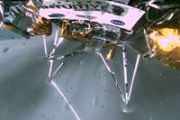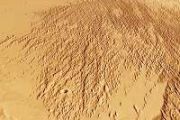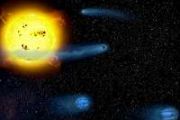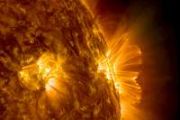
Copernical Team
Preparations underway for moon landing
 China is making preparations for a moon landing that will place its astronauts on the lunar surface, according to a senior official at the China Manned Space Agency.
Dong Nengli, head of the agency's technology bureau, said at a news conference at the Publicity Department of the CPC Central Committee in Beijing on Friday afternoon that space program planners and engineers are researching t
China is making preparations for a moon landing that will place its astronauts on the lunar surface, according to a senior official at the China Manned Space Agency.
Dong Nengli, head of the agency's technology bureau, said at a news conference at the Publicity Department of the CPC Central Committee in Beijing on Friday afternoon that space program planners and engineers are researching t Production of electricity on the Moon is in the hands of Estonians
 Katriin Kristmann, a doctoral student in chemical and materials science at TalTech (Tallinn University of Technology), began research aimed at developing technology for the production of monograin layer solar cells on the Moon.
The results of the research activity are planned to be used to provide electricity to future lunar outposts of the European Space Agency (ESA) and its international
Katriin Kristmann, a doctoral student in chemical and materials science at TalTech (Tallinn University of Technology), began research aimed at developing technology for the production of monograin layer solar cells on the Moon.
The results of the research activity are planned to be used to provide electricity to future lunar outposts of the European Space Agency (ESA) and its international CesiumAstro accelerates Active Phased Array Payload development for Lunar applications
 CesiumAstro, Inc., with support from The National Aeronautics and Space Administration (NASA), is accelerating radio frequency (RF) active phased array antenna development enabling dual function communications and sensing for lunar and cislunar applications across common Ka-band, TDRS (Tracking and Data Relay Satellite), and 5G mmWave frequency bands.
High-performance communication links f
CesiumAstro, Inc., with support from The National Aeronautics and Space Administration (NASA), is accelerating radio frequency (RF) active phased array antenna development enabling dual function communications and sensing for lunar and cislunar applications across common Ka-band, TDRS (Tracking and Data Relay Satellite), and 5G mmWave frequency bands.
High-performance communication links f Out of the Shadows of the Maria Gordon notch: Sols 3328-3329
 Our Sol 3326 drive was successful, completing our shot through the Maria Gordon notch, with its spectacular structures and deep shadows, and continuing our climb up Mount Sharp. To keep MAHLI safe over the upcoming holiday break, this plan was the last chance to take images with MAHLI's cover open until we plan the sols post-holiday, so the team was on the hunt for a good target.
For MAHLI
Our Sol 3326 drive was successful, completing our shot through the Maria Gordon notch, with its spectacular structures and deep shadows, and continuing our climb up Mount Sharp. To keep MAHLI safe over the upcoming holiday break, this plan was the last chance to take images with MAHLI's cover open until we plan the sols post-holiday, so the team was on the hunt for a good target.
For MAHLI Cliffs and notches keeps Curiosity team busy: Sols 3330-3332
 We had quite a few special investigations lately, which took the front seat (read: all our power and time) lately. They ranged from boulders to DAN investigations that saw the rover parked very close to a cliff face. We are starting this 3 sol plan with DAN passive observations to wrap up before driving away from the cliff face and a post drive DAN active.
The atmospheric investigations ha
We had quite a few special investigations lately, which took the front seat (read: all our power and time) lately. They ranged from boulders to DAN investigations that saw the rover parked very close to a cliff face. We are starting this 3 sol plan with DAN passive observations to wrap up before driving away from the cliff face and a post drive DAN active.
The atmospheric investigations ha Huayi-1 suborbital rocket makes debut flight
 The debut flight of Huayi-1 suborbital rocket took place on Friday afternoon at a testing field in northwestern China, carrying an experimental satellite to an altitude of 250 kilometers, according to a joint statement from the rocket and satellite makers.
The Huayi-1 rocket blasted off at 2:30 pm, transporting the Agile Testbed experimental satellite and a biological experimental payload
The debut flight of Huayi-1 suborbital rocket took place on Friday afternoon at a testing field in northwestern China, carrying an experimental satellite to an altitude of 250 kilometers, according to a joint statement from the rocket and satellite makers.
The Huayi-1 rocket blasted off at 2:30 pm, transporting the Agile Testbed experimental satellite and a biological experimental payload STOKE Space Raises $65M Series A to Make Space Access Sustainable and Scalable
 Reusable rocket developer STOKE Space has announced the close of a $65 million funding round that the company will use to develop its fully and rapidly reusable rocket. The funding will enable the company to conduct flight tests with its reusable second stage.
The Series A funding round was led by Breakthrough Energy Ventures and included new investors Spark Capital, Point72 Ventures, Toyo
Reusable rocket developer STOKE Space has announced the close of a $65 million funding round that the company will use to develop its fully and rapidly reusable rocket. The funding will enable the company to conduct flight tests with its reusable second stage.
The Series A funding round was led by Breakthrough Energy Ventures and included new investors Spark Capital, Point72 Ventures, Toyo Two Astronauts Receive Assignments for NASA's SpaceX Crew-6 Mission
 NASA has assigned two crew members to launch on the agency's SpaceX Crew-6 mission - the sixth crew rotation flight aboard a Crew Dragon spacecraft to the International Space Station.
NASA astronauts Stephen Bowen and Woody Hoburg will serve as spacecraft commander and pilot, respectively, for the mission. The agency's international partners will assign additional crew members as mission s
NASA has assigned two crew members to launch on the agency's SpaceX Crew-6 mission - the sixth crew rotation flight aboard a Crew Dragon spacecraft to the International Space Station.
NASA astronauts Stephen Bowen and Woody Hoburg will serve as spacecraft commander and pilot, respectively, for the mission. The agency's international partners will assign additional crew members as mission s Microlauncher competition: first payload winners chosen
 The satellite market is thriving and satellites themselves are becoming ever smaller and lighter. Around 90 percent of the satellites that will be launched into space over the next decade weigh less than 500 kilograms, which puts them in the 'small satellite' category.
They span a wide range of applications, from telecommunication services and monitoring of Earth's land, air and water mass
The satellite market is thriving and satellites themselves are becoming ever smaller and lighter. Around 90 percent of the satellites that will be launched into space over the next decade weigh less than 500 kilograms, which puts them in the 'small satellite' category.
They span a wide range of applications, from telecommunication services and monitoring of Earth's land, air and water mass SpaceX launches Turksat-5b
 SpaceX launched a communications satellite from Florida overnight Saturday for the Turkish company Turksat. Elon Musk's rocket firm launched the Turksat 5B satellite aboard a Falcon 9 rocket from Complex 40 at Cape Canaveral Space Force Station during a two-hour window that opened at 10:58 pm.
SpaceX launched a communications satellite from Florida overnight Saturday for the Turkish company Turksat. Elon Musk's rocket firm launched the Turksat 5B satellite aboard a Falcon 9 rocket from Complex 40 at Cape Canaveral Space Force Station during a two-hour window that opened at 10:58 pm. 


































